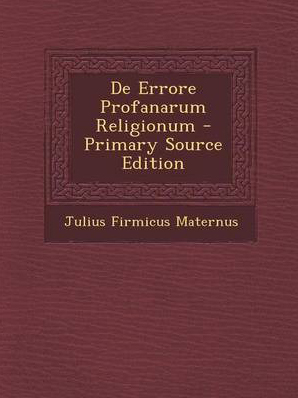Below, abridged translation from the first
volume of Karlheinz Deschner’s Kriminalgeschichte
des Christentums (Criminal History of Christianity)
A father of the Church who preaches looting and killing
And it was time for Firmicus Maternus, who expressed with joy that ‘although in some regions the dying members of idolatry still revolt, the complete eradication of such a pernicious aberration in all the Christian provinces’ seems near, which served to launch this proclamation to the Christian emperors: ‘Out with all the pagan ornaments of the temples! To the mint and the crucible with the metal of the idolatrous statues, so that they melt in the heat of the flames!’
In the diatribe De errore profanarum religionum (“On the error of profane religions”), written about the year 347, Firmicus incites emperors Constans and Constantius, called ‘sacratissimi imperatores’ and ‘sacrosancti’ to the extermination, above all, of mystery cults: the most dangerous for Christianity. These were the cults of Isis, Osiris, Serapis, Cybele and Attis, Dionysus-Bacchus and Aphrodite, and the solar cult of Mithraism, the most powerful of the time, characterized by numerous and surprising parallels with the Christian religion.
 Many Catholic authors still deny (despite having proved incontestably in 1897) that Firmicus was the author of those bloodthirsty diatribes, which are discredited by their fanatical style full of pleonasms, prototype of future Catholic rhetoric and pamphlets.
Many Catholic authors still deny (despite having proved incontestably in 1897) that Firmicus was the author of those bloodthirsty diatribes, which are discredited by their fanatical style full of pleonasms, prototype of future Catholic rhetoric and pamphlets.
Christ, the father of the Church congratulates himself, ‘he has knocked down the column where the devil had his image’, which appears thus ‘almost defeated, turned into fire and ashes’. ‘Little is left now for the devil, totally overwhelmed by your laws, to be totally destroyed, putting an end to the disastrous contagion, once the worship of idols, that poison has been exterminated. Celebrate with jubilation the annihilation of paganism, sing in full voice the hallelujah, for you have won as soldiers of Christ’.
Not yet, however. The religiones profanae still existed, almost all the temples still stood and the pagans still came to their sanctuaries. For this reason, the agitator demands the confiscation of their property, the destruction of the centres of worship. ‘Melt the figures of the gods and mint your coins with them; incorporate the votive offerings into the imperial treasury. The Lord has called you to higher undertakings, when you have crowned the task of annihilating all the temples’.
The spread of Christianity was the highest enterprise, along with the eradication of the pernicious pagan doctrines. Of course, adepts of the Greco-Roman world did not think so, but the other way around. ‘The opinion that, with the irruption of Christianity in the world, it had begun a general decline of the human species’ (Friedlander) was gaining strength.
Always invoking the Yahweh of the Old Testament, as is logical, until then no Christian had claimed with so much emphasis heir to the biblical hecatombs, nor had he used the precedent so systematically to justify resorting to brutality and terror. God threatens even the family and children of the children, ‘lest the cursed seed survive, and there be no trace of the heathen generations’.
As soon as the Church found itself in a position of strength, it stopped rejecting violence in order to exercise it ‘by all means’, as the theologian Carl Schneider says. The old apologetics that spoke of freedom of cults is displaced by libel and diatribe; the ideology of martyrdom and the exemplary lives of the martyrs no longer matters, it is the hour of persecuting fanaticism, of ‘the powerful calls to the crusade’ by a Firmicus ‘denigrating non-Christian religions like no other before him’ (Hoheisel).
The emperors, certainly, were the ones who had the means to apply coercion and violence. But they were also Christians and many proofs will not be necessary to suppose that the book of Firmicus Maternus, dedicated to the emperors Constantius and Constans, would not fail to influence in some measure the anti-pagan policy of them; their prohibitions and their threats. And these, in turn, would determine the position of the author of that Christian pamphlet.